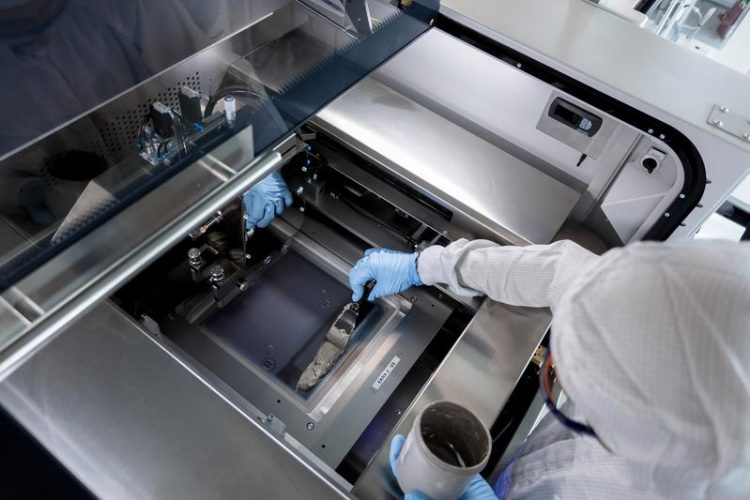Innovative Fine-Line Screen Printing Metallization Reduces Silver Consumption for Solar Cell Contacts

View inside of a screen printing machine © Fraunhofer ISE / Dirk Mahler
Silicon solar cells rely on metal electrodes on their front and rear sides to carry the electrical energy generated in the semiconductor material from light irradiation. To this end, a flatbed screen printing process is typically used to print a fine contact grid onto the front side of the cell.
This grid should block as little as possible of the active cell surface from exposure to light and must be sufficiently conductive to keep the solar cells’ series resistance low. The technological challenge in the screen printing process lies in creating the narrowest possible continuous contact fingers with a sufficient height for good lateral conductivity.
Printing extremely fine contact fingers requires the use of highly engineered specialized screens and metallization pastes in addition to complete mastery of the screen printing metallization process.
“Working together with industry partners in fine-line screen printing metallization, in particular with screen manufacturers Koenen GmbH and Murakami Co. Ltd. as well as screen chemical supplier Kissel + Wolf GmbH, we have managed to reduce the contact fingers’ width to less than 20 micrometers — a reduction of 30 to 40 percent compared with the current industry standard,” explains Dr.-Ing. Andreas Lorenz, project manager in the Printing Technology group at Fraunhofer ISE.
Innovative fine-mesh screens were used in the metallization of passivated emitter and rear contact (PERC) solar cells in two independent test series. Using such a screen made it possible to create contact fingers with a width of merely 19 µm and a height of 18 µm in a single printing step. Not only are the contact fingers extremely narrow, their electrical properties are also outstanding.
When integrated into modules — particularly with newer technologies such as multi-busbar interconnection with 8 to 15 busbars — they enable a notable reduction of the power loss in the contact fingers. These newly developed screen printing processes require up to 30 percent less silver compared with the current industry standard with a contact finger width of approximately 30 µm.
As part of the experiment, PERC solar cells were metallized using the optimal screen parameters; a nominal finger width of 24 µm was selected due to the limitation with regard to the available number of busbars on the solar cell (in this case 5). The best PERC solar cell in this test series achieved an efficiency of h = 22.1%.
“Using highly engineered screen and paste systems for fine-line metallization, it could be possible to start manufacturing solar cells with nearly invisible contact fingers on an industrial scale in the near future. This would represent a great advantage for applications in integrated photovoltaics, where aesthetic, homogeneous module surfaces are in demand,” says Dr. Florian Clement, Head of the Production Technology — Structuring and Metallization Department at Fraunhofer ISE.
The results of these test series will be presented at two upcoming PV conferences — the 36th EU PVSEC in Marseille, France, and the 29th PVSEC in Xi’an, China.
The collaborative project “FINALE” (https://www.ise.fraunhofer.de/en/research-projects/finale.html), which focusses the development of fine-line screen printing processes and in which the researchers partly achieved these results, was funded by the German Federal Ministry for Economic Affairs and Energy BMWi and conducted in collaboration with industry partners Koenen GmbH, Kissel + Wolf GmbH and Wickon Hightech GmbH.
Further fine-line screen printing results which are presented here were realized within a cooperation between Murakami Co. Ltd. and Fraunhofer ISE.
https://www.ise.fraunhofer.de/en/press-media/press-releases/2019/innovative-fine…
Media Contact
All latest news from the category: Life Sciences and Chemistry
Articles and reports from the Life Sciences and chemistry area deal with applied and basic research into modern biology, chemistry and human medicine.
Valuable information can be found on a range of life sciences fields including bacteriology, biochemistry, bionics, bioinformatics, biophysics, biotechnology, genetics, geobotany, human biology, marine biology, microbiology, molecular biology, cellular biology, zoology, bioinorganic chemistry, microchemistry and environmental chemistry.
Newest articles

Bringing bio-inspired robots to life
Nebraska researcher Eric Markvicka gets NSF CAREER Award to pursue manufacture of novel materials for soft robotics and stretchable electronics. Engineers are increasingly eager to develop robots that mimic the…

Bella moths use poison to attract mates
Scientists are closer to finding out how. Pyrrolizidine alkaloids are as bitter and toxic as they are hard to pronounce. They’re produced by several different types of plants and are…

AI tool creates ‘synthetic’ images of cells
…for enhanced microscopy analysis. Observing individual cells through microscopes can reveal a range of important cell biological phenomena that frequently play a role in human diseases, but the process of…





















